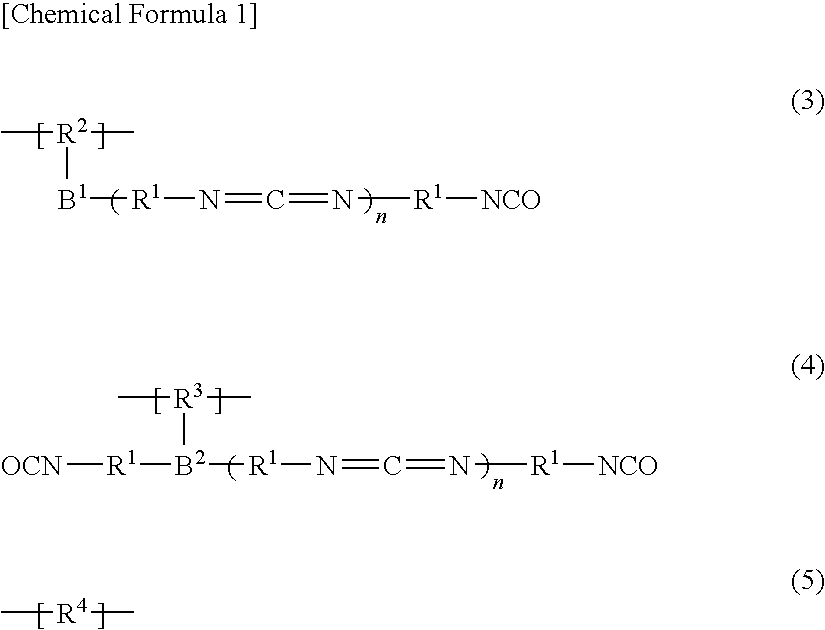Flame retardant and inorganic/organic composite flame-retardant composition
a flame retardant and inorganic/organic composite technology, applied in the direction of group 5/15 element organic compounds, natural mineral layered products, synthetic resin layered products, etc., can solve the problems of increased production costs, limited use of halogenated compounds and antimony trioxide, and flame retardant compositions
- Summary
- Abstract
- Description
- Claims
- Application Information
AI Technical Summary
Benefits of technology
Problems solved by technology
Method used
Image
Examples
synthesis example 1
[0196]A 300 ml three-necked flask was charged with 100 g of 4,4′-dicyclomethane diisocyanate (produced by Bayer; abbreviated below as “HMDI”) and 0.5 g of 1-phenyl-2-phospholene-1-oxide (abbreviated below as “p-cat”) was added as the catalyst, following which the flask contents were stirred for 24 hours at 180° C. under nitrogen bubbling. The resulting carbodiimide compound was diluted with 35 g of toluene (Kanto Chemical Co., Ltd.) and cooled to 0° C., following which 40 g of 3-aminopropyltriethoxysilane (a silane coupling agent produced by Chisso Corporation) was slowly added dropwise under stirring. After 12 hours of reaction at 0° C. in a nitrogen atmosphere, the isocyanate group peak in the IR spectrum for the carbodiimide compound was confirmed to have vanished and the reaction was stopped.
synthesis example 2
[0197]A 300 ml three-necked flask was charged with 100 g of 1,3-bis(1-isocyanato-1-methylethyl)benzene (produced by Takeda Chemical Industries, Ltd.; abbreviated below as “TMXDI”) and 2.0 g of p-cat was added as the catalyst, following which the reaction was carried out for 12 hours at 180° C. under nitrogen bubbling. Next, 0.6 g of aminostyrene (Wako Pure Chemical Industries, Ltd.) and 0.9 g of n-dodecylamine (Wako Pure Chemical Industries) were reacted with 10.0 g of the resulting carbodiimide compound for 5 hours at 0° C. and under nitrogen.
[2] Flame Retardant
Inorganic Hydroxide Particles Having Carbodiimide Group-containing Organic Layer
example 1
[0198]Mg(OH)2 (10.0 g; Kisuma 5Q, a surface-untreated Mg(OH)2 produced by Kyowa Chemical Industry Co., Ltd.) having a volume mean particle diameter of 700 nm was thoroughly dispersed in 40.0 g of cyclohexanone (Wako Pure Chemical Industries) within a 100 ml round-bottomed flask, following which 0.03 g of 3-aminopropyltriethoxysilane (a silane coupling agent produced by Chisso Corporation) was added and the flask contents were stirred for 30 minutes at 65° C. Next, 0.5 g of 2,4-diisocyanatotoluene (Takeda Chemical Industries) and 0.02 g of p-cat as the catalyst were added and the flask contents were stirred for 1 hour at 65° C., after which 0.02 g of the catalyst p-cat and 0.12 g of n-dodecyl alcohol (Kanto Chemical) as an end-capping agent were added, and the system was heated at 70° C. for about 15 hours to effect the reaction.
[0199]Following reaction completion, the Mg(OH)2 particles were washed with tetrahydrofuran (abbreviated below as “THF”; Wako Pure Chemical Industries) and s...
PUM
| Property | Measurement | Unit |
|---|---|---|
| volume mean particle diameter | aaaaa | aaaaa |
| surface area | aaaaa | aaaaa |
| particle size distribution | aaaaa | aaaaa |
Abstract
Description
Claims
Application Information
 Login to View More
Login to View More - R&D
- Intellectual Property
- Life Sciences
- Materials
- Tech Scout
- Unparalleled Data Quality
- Higher Quality Content
- 60% Fewer Hallucinations
Browse by: Latest US Patents, China's latest patents, Technical Efficacy Thesaurus, Application Domain, Technology Topic, Popular Technical Reports.
© 2025 PatSnap. All rights reserved.Legal|Privacy policy|Modern Slavery Act Transparency Statement|Sitemap|About US| Contact US: help@patsnap.com

